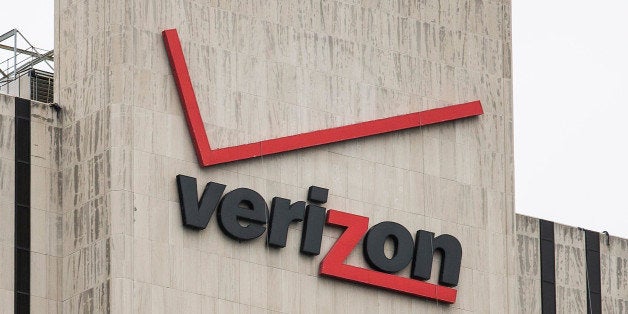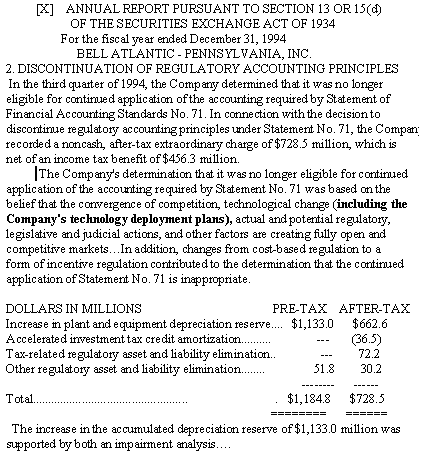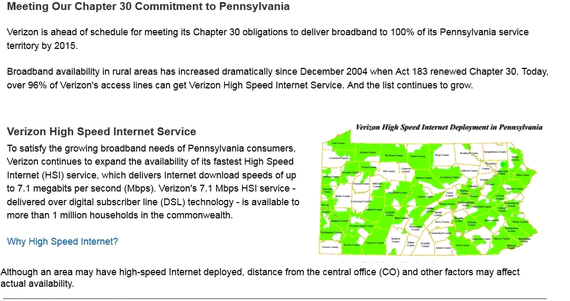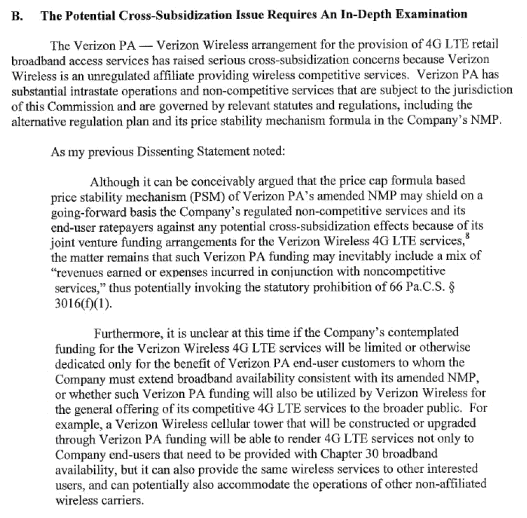
For the Full Story See: "The Book of Broken Promises: $400 Billion Broadband Scandal and Free the Net"
The Promise
Starting in the 1990s, Verizon (formerly Bell Atlantic) went state to state, claiming that if state laws were changed in their favor, the company would replace the existing copper-based infrastructure of the state utility networks with a fiber optic wire that would deliver fabulous new services, including very high-speed broadband, at speeds of at least 45 Mbps in both directions.
And as part of these agreements, in Pennsylvania, Verizon is supposed to have their entire territory completed by the year 2015, while New Jersey's broadband plan required 100% completed by the year 2010 -- that's everyone in their territory, including rural areas, low income areas -- ALL locations.
And this was big news, as told by articles by the Pennsylvania media and around the US. Just the headlines of these stories gives a flavor of what would be the Keystone State's fiber optic future.
- "PA Senate OKs Fiber Optics Bill" June 24, 1993, Philadelphia Daily News.
- "PA Legislature Compromises on Fiber-Optics Bill. The Measure Calls for the State to Be Wired By 2015". June 25, 1993, Philadelphia Inquirer.
- "Phone Bill Goes To House. The Pa. Measure Would Limit Rate Increases and Require A Fiber-Optic Network by 2015". May 24, 1993, Philadelphia Inquirer
Notice the word 'fiber optics'. This is 22 years ago.
And the deal -- If the State granted higher profits (read rate increases on phone customers) and gave tax breaks, this extra money would be used to pay for constructing these new networks over the next 20+ years. In Pennsylvania, the state law was changed in 1993, known as "Chapter 30", and after some discussions at the Pennsylvania Public Utility Commission (PUC), by 1995 a plan was agreed to that would start in 1995-1996.
And the specifics: The State required universal broadband capable of 45 Mbps in both directions by 2015: (Taken from the PA PUC meeting and Order about the commitments, March, 2002.)
"Bell commits to deploy the technologies necessary to provide universal broadband availability in 2015. In order to meet this commitment, Bell plans to deploy a broadband network using fiber optics or other comparable technology that is capable of supporting services requiring bandwidth of at least 45 megabits per second or its equivalent."
It would be bi-directional, meaning it would be fast in both directions. The Commission also stated:
"In view of Bell's commitment to providing 45 Mbps for digital video transmission both upstream and downstream, we look forward to Bell's providing this two-way digital video transmission at 45 Mbps."
This 'information superhighway' was also to go equally to rural, urban and suburban areas. According to the PA Public Utility Commission:
"Verizon PA has committed to making 20% of its access lines in each of rural, suburban, and urban rate centers broadband capable within five days from the customer request date by end of year 1998; 50% by 2004; and 100% by 2015."
And it would be delivered to a customer within five business days.
"Bell Atlantic-Pennsylvania can provide services at speeds of 45 Mbps or greater to a customer location within five business days..."
(Of course, along the way, this provision to deliver services in 5 days was changed to 10 business days.)
In fact, in 1996, Verizon (Bell Atlantic's) press release stated that the company's fiber optic broadband networks would start in Philadelphia and southeastern PA in 1996 and reach 12 million homes and small businesses by the year 2000.
"Bell Atlantic plans to begin its network upgrade in Philadelphia and southeastern Pennsylvania later this year. The company plans to expand this Full Service Network deployment to other key markets over the next three years. Ultimately, Bell Atlantic expects to serve most of the 12 million homes and small businesses across the mid-Atlantic region with switched broadband networks."
The First Bait & Switch: Verizon Got Paid for Fiber Optics but Rolled Out DSL Over the Existing Copper.
Unfortunately, by the end of 1998 it was all make believe. There had been no building of the new networks, just major profits and perks to the company. Economics & Technology, a respected research firm, released a report that detailed what happened:
"In 1993, the Pennsylvania legislature added Chapter 30 to the Public Utility Code with the specific goal of assuring that all areas of the state will be provided with a modern, state-of-the-art broadband telecommunications infrastructure. Basically, Chapter 30 offered Pennsylvania's incumbent local exchange carriers (ILECs) a quid pro quo: In exchange for a firm commitment to provide broadband service capability throughout its entire network by the year 2015, each participating ILEC would become subject to an "alternative form of regulation" providing substantially greater pricing and earnings flexibility than the traditional "rate of return" form of regulation under which the ILEC's prices and earnings had been set."Having made its 'commitment' and been granted its "alternative regulation" reward, Pennsylvania's largest local telephone company -- Bell Atlantic-Pennsylvania (BA-PA) -- has paid more attention to escaping from, rather than fulfilling, the terms of its promised upgrade. This study demonstrates that, despite strong financial performance and earnings growth in Pennsylvania, as well as a generous and flexible regulatory framework, BA-PA has failed to increase investment in the state's telecommunications network and, in fact, has actually extracted capital out of Pennsylvania for use elsewhere.
"At the same time, BA-PA has been extremely successful in protecting its monopoly from competitive encroachment. Without the discipline of actual, effective competition, the incumbent has been permitted to charge excessive prices and earn excessive profits, while confronting no business incentive to undertake new investment in Pennsylvania. As we approach the end of 1998 -- a point by which BA-PA is supposed to have broadband available throughout 20% of its rural, urban and suburban areas -- there is no sign of any broadband service being offered to Pennsylvania's residential customers."
By 2002, there was still no fiber optic networks built and the company had continued rolling out DSL over the old, existing copper wire. The State wrote that DSL did not fulfill the obligations.
"We believe that DSL, as presently offered by Verizon PA, has too many limitations in its capabilities to be considered a broadband service as defined by Chapter 30 and Verizon PA's 1995 NMP (modified plan)."
In fact, back in 1992, DSL was considered inferior as it relies on the old copper wiring and it could not deliver the 45 Mbps speeds, much less support cable TV competition.
The Second Bait & Switch -- Company Got Billions for Fiber, Yet the State Law Immortalized 1.5 Mbps Instead of 45 Mbps.
In 2003, because of a 'fine print' issue in the original law, (weasel room), Verizon was allowed to replace the commitments of 45 Mbps in both directions with 1.5 Mbps in one direction, through a decision of an administrative law judge.
This abysmal speed is 19 times slower than what was committed to and paid for. In fact, there would have been no reason to change the law in the first place for 1.5 Mbps services because it can't do HD quality video or offer cable competition, which was one of the main selling points to give the company more money to do the build outs in the original agreement.
And insult to injury, by the end of 2003, Verizon had collected almost $4 billion -- approximately $1,135 per household, from excess phone rates and tax perks, paid by customers for a fiber optic upgrade that never happened.
Teletruth filed a complaint with the State, documenting this excess, which was based on the company's own financial reports and reports by other research firms and the PA State's consumer advocate office.
"By the end of 2003, Teletruth estimates that every household in Pennsylvania has paid in excess of $1,135.00 for a fiber optic service they will never get. Teletruth estimates that the total overcharging to be $3.9 billion or more in excess profits, tax deductions, and other financial perks, including funding other business ventures through cross-subsidization."
Verizon also Got Massive Tax Breaks for this Broadband Deployment, Starting in 1994.
Recently, (April 2015) a TV media company decided to not run an investigation we had worked on together about Verizon's failure to properly upgrade the networks by 2015. After an interview with Verizon by the company, the word 'liabilities' entered their vocabulary and they doubted that there was a tax break that came with the Chapter 30 Pennsylvania broadband plan.
The excerpt below is from Verizon Pennsylvania's 10K Annual Report (which was filed with the SEC), showing a massive tax deduction for the year 1994; something called FAS71. And it specifically states that this was done as part of the "company's technology deployment plan", i.e., the Chapter 30 Pennsylvania deployment plan. Also, the deduction was taken, according to Verizon, because of "changes in cost-based regulation to incentive regulation" -- i.e., the changes in the law that gave the company more 'incentives' and more profits was the reason the company could take this tax deduction. This was on top of the freedom granted in the new regulations to speed up tax write offs of the aging copper wire, known as "accelerated depreciation", meaning more tax write offs, faster.
And it was huge amount: Verizon increased the 'depreciation reserve', i.e., took tax write offs of $1.2 billion, resulting in a $728 million one-time charge, "after tax". The problem of course is... if the copper wires weren't replaced, how did the company take a billion dollar deduction?
=====
In 2004, the PA State law was again changed, immortalizing the speed of 1.5 Mbps, but it kept the timeline to have Verizon PA complete broadband coverage, 100%, by 2015.
In 2005-2007, depending on the state, Verizon started the roll out of FiOS, its fiber optic service. But it was short lived. In 2012, Verizon announced that it was stopping their FiOS deployments throughout the US, except where there were previous commitments.
Bait & Switch Three: They Got Laws Changed to Substitute Wireless?
It is 2015, and Verizon has filed with the State claiming that they have 96% of the Verizon Pennsylvania territory finished and on schedule for completion by the end of 2015. (Verizon also includes "Verizon North", which was part of the old independent GTE and Contel territories, and was taken over by Verizon.)
Going through the coverage area of Pennsylvania using Census data, and then calculating the percentage that Verizon PA covers of Pennsylvania, based on FCC data, as well as incorporating the statements made by the company about deployments, we find that when cross checked, most of the State is not completed with a wired service.
(NOTE: Verizon PA has filed with the State additional information that is not public and may contradict their other public statements, such as the information below.)
NOTE: There is a series of caveats about the language used by Verizon. "Housing units", "households", "homes", "businesses", "firms", "establishments", "locations", and "premises" all have different technical meanings. For example, Verizon claims FiOS passes 2 million 'homes and businesses', which is different than the claim it passes 1 million "homes" with DSL, alone.
- A.Census data shows that there were 5.6 million housing units and 981,000 businesses in Pennsylvania as of 2013, for a total of 6.5 million 'locations'.
- B.The FCC data shows that Verizon PA had 82% of the State covered in 2007, and this would include Verizon PA and Verizon North. (2007 is the latest available data.)
- C.This would mean that Verizon covers approximately 4.6 million housing units and 800,000 businesses, for a total of 5.4 million 'locations'.
- D.Verizon states that DSL is available to 1 million 'homes'.
- E.Verizon's press release for the end of 2014 states Verizon had covered, with FiOS, 2.0 million 'households and businesses' that could get the service.
- F.Adding these two numbers gives us 3.0 million available 'broadband' 'locations', (though it includes businesses for FiOS and not for DSL.)
- G.Just comparing this 3.0 million with the Census (adjusted) for housing units comes to 66% coverage.
- H.Using the same 3 million-- If you take the Verizon numbers for FiOS and DSL and compare them to 'locations', there is only 56% coverage in the State.
- I.If you do FiOS and Housing units, we get 44%.
- J.Bottom Line: FiOS and "Locations" - 37.3%
Caveats lower these numbers even further.
- K.There could be at least a 20%-50% overlap between DSL and where FiOS was deployed.
- L.At least 5%-20% of rural area customers could be 'out of range' to get the service.
- M.Accounting holes: 10%-30%. Throughout the US, from the union installers of FiOS to the customers who can't get service, reports abound about customers who can't get FiOS in areas that are supposed to be completed.
But it gets worse because Verizon appears to be counting customers that can't get service and includes this caveat, below, in their 1 million DSL line accounting. Simply put, it says that while the company has 'deployed' higher speed services, customers may not be able to get any service due to 'distance' from the Verizon main location (central office) or other factors.

The company had about 20 years to make sure that this problem was solved as the law requires that rural, suburban and urban areas were treated equally.
The Kicker: Replace the Obligation of Fiber with Wireless -- Bait & Switch 3.
In 2011, Verizon Pennsylvania got the State to allow Verizon PA to use Verizon Wireless's services instead of upgrading the utility's wired infrastructure to fulfill their obligation of broadband coverage. This means that the remaining 60% will not get upgraded. Talk about a bait & switch...
Verizon's very expensive wireless broadband service cost, besides the basic fees, $60.00 for 10 gigs; that's just a few HD movies on Netflix. DSL is at least a flat fee at $19.99-$29.99 advertised rate, (but requires 'home phone service' as well), but it doesn't cost hundreds of dollars extra month, especially for those who watch video or want a substitute for cable TV. See chart for comparison of DSL, FiOS and Wireless.
Bait-&-Switch 4: Massive Cross-Subsidies of the Wireless Company
And finally, like our revelations about Verizon's New York's massive cross-subsidies of the wireless business where the wireless company appears to be able to dump the wireless expenses, like wires to the cell towers, into the State construction budgets and other perks, Verizon PA appears to be using the same shell game mathematics. One PA PUC Commissioner was concerned about the ties between Verizon Wireless and Verizon PA's wired networks and wrote this as part of his dissenting statement in a case where customers were denied DSL service and forced to use wireless in 2013.
Simply put -- instead of upgrading customers who paid thousands of dollars for wireline upgrades, Verizon is diverting funds to build and give financial help to their other businesses, including Verizon Wireless.
Overcharging -- We estimate that by the end of 2014, Verizon PA overcharged customers about $18 billion for a fiber optic future they never got; this doesn't include the monies from the cross-subsidies of the wireless networks and other lines of business which we recently uncovered. However, audits would be needed to determine the exact amount.
Based on these cross-subsidies, not to mention a history of the bait & switch tactics, shouldn't the State Auditor General and other government agencies investigate these financial issues and answer the question -- Why is Pennsylvania not a fiber optic state and how were customers continuously charged over the last two decades for a fiber optic, 'info highway' and instead got a dirt road in much of the State?




